Anyone with reduced mobility can greatly benefit from a bedside commode. My 91-year-old mom has been using one for several years now, and to say she is happy with it is an understatement. It also gives me peace of mind at night knowing that she has this to use over our toilet, that she finds it easy to use, and is safe doing so.
The Benefits of bedside commodes are –
- safety
- creates greater independence, freedom and control
- can lead to increased privacy and sense of dignity
- easy and quick access
- wheelchair users may find it easier than a toilet
- comfortable option for bedridden individuals
- can increase user confidence
- height adjustable
- models in all sizes
- low-cost option
- no need for home renovation
- can be placed anywhere in the home
- extremely portable
- models with wheels
- some models have multiple uses
- can be used over an existing toilet
- a safe option after hip or knee replacement surgery
- less stress for caregivers than a conventional toilet
- more sleep for caregivers
Contents Overview & Quicklinks
What is a medical commode or bedside commode ?
What is the purpose of a bedside commode ?
The benefits of a bedside commode
- Bedside commodes give increased safety for users
- Bedside commodes can lead to greater independence
- Bedside commodes give increased privacy and sense of dignity
- Bedside commodes are easy to use
- Wheelchair users can use a bedside commode, which may be easier than the toilet if you have little space
- Bedside commodes are more comfortable to use than a bed pan
- Bedside commodes can increase user confidence
- Bedside commodes are typically height adjustable
- Bedside commodes come in a wide range of sizes for all users
- Most bedside commodes are very affordable
- Bedside commodes remove the need for home renovation
- Bedside commodes can be placed anywhere in the home
- Bedside commodes are extremely portable and lightweight, making it easy for caregivers to move around
- Some bedside commodes have multiple uses
- 3-in-1 bedside commodes can be used over the toilet
- Bedside commodes are a safe option after hip or knee replacement surgery
- Bedside commodes can be quickly placed anywhere needed
- Bedside commodes can mean more sleep for caregivers
- Some bedside commodes come with wheels -rolling commodes
How to use a bedside commode ?
How to transfer to a bedside commode ?
What is a medical commode or bedside commode ?
A medical, or bedside commode, is a chair toilet which does not use running water, and which can be placed by the bed, or at any location in the home.
The commode has a chair frame with a toilet seat, under which a pale is slotted so that it may be used as a toilet.
Two main categories of bedside commode exist –
- static portable bedside commodes
- rolling bedside commodes
Static bedside commode types –
- simple folding commode
- stacking bedside commode
- 3-in-1 commodes or All-in-One commodes
- drop arm commodes (this can be a specific type or a feature that you find on other types)
- static shower commode
The static commodes are the type of commode that you are most likely to be using if you just need a portable toilet by the bed, and possibly to put over the toilet.
The rolling commodes come in two types –
- transport bedside commode
- shower chair transport bedside commode
Rolling commodes have wheels, which means that they can additionally be used for transporting a person from A to B.
The shower transport commode adds the extra option of wheeling into the shower for washing.
One last point about rolling commodes is that each type has two versions –
- attendant – for this, a second person or caregiver is required to push the commode chair
- self-propelling – this type of commode chair has wheelchair wheels and the user can independently wheel themselves around, making them far more autonomous
Bariatric or Heavy Duty Commodes
All types of bedside commode come in models with different weight capacities.
Bedside commodes that support maximum weights up to around 350 lb are standard, anything above that is called a “bariatric” or a “heavy duty” bedside commode.
Commodes may also have variations of width, height and some changes in the form of the seat to facilitate the task of cleaning oneself when seated on the commode.

Bariatric full width commode
What is the purpose of a bedside commode ?
The purpose of a bedside commode is to make it possible to go to the toilet where there is no running water, and to make it easier, simpler and safer for those individuals who have trouble getting to and, or, using a toilet, because of physical issues.
Typically, it is used by people who are disabled, or have limited movement due to a medical condition, surgery, and injury or simply old age.
A bedside commode can typically be adjusted in height, to suit the needs of the user, making it much easier for the user to sit and stand due to the reduced distance that they need to bend.
The portability of commodes serve to reduce the distance a user needs to walk to use a toilet, again making it easier and safer for a user who has problems with mobility.
And if you are looking for a post which covers all aspects of the different types of bedside commodes –
- the types
- set up
- who needs one
- using over a toilet
- liners emptying
- cleaning
- odor control
- where to buy
- top brands
- bedside commodes for larger people
- using over the toilet
- maintenance
- features
- sizes
- and more
You can find all of that in this article, “What is a bedside commode ?”.
The benefits of bedside commodes
Bedside commodes give increased safety for users
- bedside commodes have large armrests which are easy to grab onto, making it easy for a disabled or elderly user to lower themselves onto the commode seat in all safety, something which is obviously not true of a toilet unless grab bars have been put in place
- a bedside commode if it is placed in a bedroom, or any room other than the bathroom, is essentially in a safer place – 85% of all falls occur in the bathroom, due in part to slippery surfaces – if you place the commode in any other room on a commode mat which is non-slip, you are already making it safer than the bathroom environment
- give lots of room – whereas a bathroom can be difficult to use for a person with mobility issues, it is easy enough to place the commode in a space which is free of any hazards, but kitted-out with all they need
- peeing at night – with a bedside commode there is no need for an elderly or disabled person to walk to the bathroom, the commode can be right by the bed which reduces the chance of falls – you can also use lights with remote sensors which will turn on when the person gets up from the bed making it easy for them to see the commode, and the lights will turn off typically 3 minutes after no more movement has been sensed
To learn more about the best raised toilet seats and bedside commodes for elderly adults, you can read my article, where I select different seats for different situations – “Best Raised Toilet Seats For Elderly Seniors: A Detailed Guide With Prices”
Bedside commodes can lead to greater independence
- it may be that some loved ones are loath to call at night for help because they need to go to the toilet, and rather than doing so they will wait unhealthy amounts of time until their carer is awake
- if there is a bedside commode next to the bed that a person is able to use on their own, rather than disturbing a sleeping carer, they will be able to do so and will gain in their independence
Bedside commodes give increased privacy and sense of dignity
- with the increased security of sitting on a bedside commode as opposed to a toilet, a user who is able to now go to the toilet on their own and to do this without assistance can have some of their privacy restored to them, and they don’t have to go through the undignified process of being helped at such intimate times
- the seats that come with the different models of bedside commode – elongated or open, also facilitate access for cleaning oneself
- the availability of larger bariatric commodes also means that where a larger person need help on a toilet, on a bariatric commode where they have a large seat and are well-supported, they can clean themselves without help
There are bedside commodes which even look like armchairs, and unless you took the chair apart you would never guess it.
If you want to know more about these armchair commodes, and find examples, you can check out my article “14 Perfectly Discreet Commode Chairs: No One Will Ever Know !”
If you are looking for a way to hide yours, or a loved one’s bedside commode because you think it is just a bit too much in plain site, which is understandable, then you can find out lots of pointers on how to do this in my article “How To Hide A Bedside Commode ?”.
Bedside commodes are easy to use
- a bedside commode is very easy to sit on because of the armrests, and much more so than a toilet
You can find out lots of useful tips for using bedside commodes, cleaning them, setting them up, keeping the odors to a minimum, and a lot more in my article “100 Plus Truly Practical Tips On How To Use & Clean Bedside Commodes”.
Wheelchair users can use a bedside commode, which may be easier than the toilet if you have little space
- drop arm commodes are specifically designed to have armrests which may be raised, lowered and sometimes removed, so that access to the bedside commode is gained for a side transfer
- wheelchair users can often use a normal toilet, but if they cannot a drop arm bedside commode is designed for transfer either from a wheelchair, or a bed
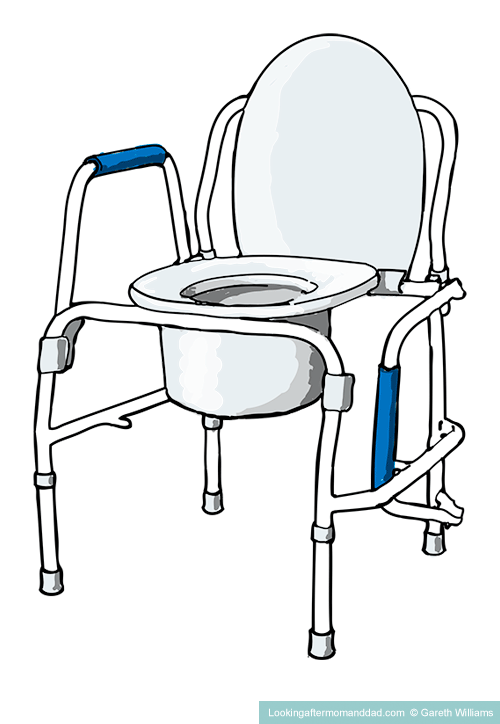
Drop arm bedside commodes
Bedside commodes are more comfortable to use than a bed pan
- for a person who is bedridden a drop arm bedside commode, if they have the use of their arms, is a more comfortable way of going to the toilet than a bedpan
- the person slides off the bed onto the bedside commode and can then be left in private to use the commode and, if they are able, to clean themselves and transfer back to the bed
- if they can do this, it will return some person’s dignity and the feeling of being helpless and so dependent on others
Bedside commodes can increase user confidence
- because the bedside commode has armrests that you can hold onto, it means that persons with limited strength, balance or mobility can feel more confident going to the toilet, as the chance of falling is reduced
- the fact that when seated on the bedside commode you have the armrests on either side and the backrest behind and there is a feeling of being supported and surrounded (on three sides) which there is not on a conventional toilet, which also may help the person to feel more comfortable and sure of themselves
- after a period of time of using a bedside commode it is not unreasonable to suggest that a person may increase in confidence in other activities as a result of being able to do a little more by themselves than before – there is no guarantee, but everything builds in little steps
Bedside commodes are typically height adjustable
- the majority of bedside commodes come with adjustable height legs which allows the user to adjust the height to their own body
- the height can also be adjusted to raise the level of the seat, and so relieving issues for individuals who have problems bending to sit or to stand
- the height adjustment is also used when placing a commode over a toilet a a raised toilet seat or toilet safety frame
Bedside commodes come in a wide range of sizes for all users
- bedside commodes come in a whole range of sizes, weight capacities and widths
- some shower chair transport commodes come with a whole menu of seat sizes, widths and weight capacities to fit as many users body types as possible
The following articles all about the different sizes, and modifications that you can find on bedside commodes, and may help to understand the variety that is out there, and in particular for larger individuals. In the articles on weight limits, these are essentially very long lists of bedside commodes available in different user weight categories, and they are all accompanied by their model numbers and full model name.
“Do Bedside Commodes Come In Different Sizes ?”
“How Wide Is A Bariatric Commode ?”
“Bedside Commode Weight Capacity: A Guide With Over 140 Examples and Illustrations”
“Bariatric Bedside Commode Weight Limits: A Guide With 60 Examples and Illustrations”
“Raised Toilet Seats For A Large Person : The complete guide”
Most bedside commodes are very affordable
- bedside commodes are not that expensive for standard models – anywhere from 40 to $100 for a standard bedside commode
- only some very heavy duty bariatric commodes are more expensive, but that is because of the materials and the load they have to take
If you want to take a look at a large range of bedside commode prices, to see what is out there, and where you can find them, this article will give you that information “How Much Does A Raised Toilet Seat Cost ?”
Bedside commodes remove the need for home renovation
- a bedside commode is also far cheaper than plumbing in a new toilet with all kinds of safety grab bars around it in a bedroom, you just clear a space and place it there
- if you have a problem with the odors you can simply put in an extractor fan, and that is far cheaper than a renovation of the whole bedroom
Bedside commodes can be placed anywhere in the home
- the bedside commode can be placed anywhere there is space in the home
Bedside commodes are extremely portable and very lightweight, making it easy for caregivers to move around
- bedside commodes are typically made from aluminum and plastic for the standard models and for the heavy duty steel tubing and plastic, but they very rarely weigh much at all, and are very easy for a carer to lift and re-position
- my mom who is 92 can pick up here commode from over the toilet and put it in another room – I ask her not to, but does she listen …
Some bedside commodes have multiple uses
Some bedside commodes have multiple uses –
- 3-in-1 bedside commode – bedside commode, raised toilet seat and toilet safety frame
- adjustable height stacking bedside commode – bedside commode, raised toilet seat and toilet safety frame
- transport bedside commode – transport commode, raised toilet seat (not all models) and bedside commode
- shower chair transport bedside commode – shower chair, transport commode, raised toilet seat (not all models) and bedside commode
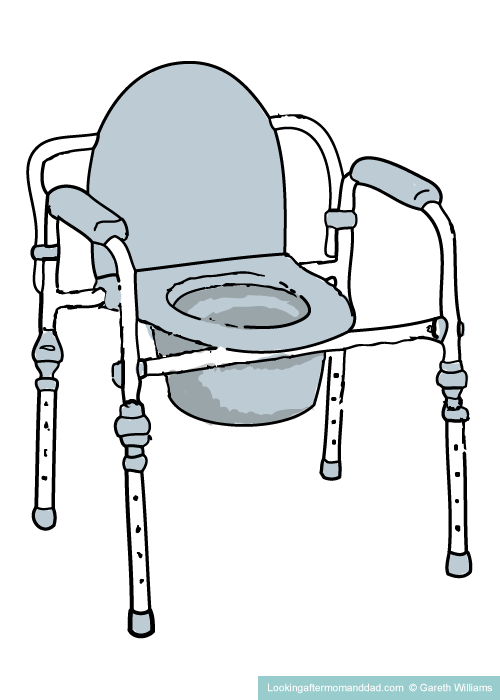
3 in 1 bedside commode
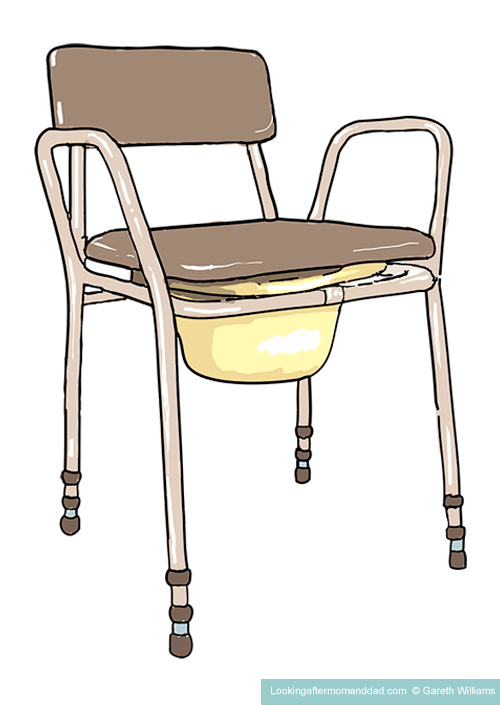
static stacking bedside commodes
3 in 1 bedside commodes can be used over the toilet
- a 3-in-1, or All-in-One, or adjustable height stacking bedside commode can be used over a toilet
- the three types of commodes which I just listed can be adjusted to have the correct height to be positioned over a toilet, once the original toilet seat and lid are in the upright position, and to be used as a raised toilet seat, or
- as a safety frame – the seat of the commode in this case is set to it’s lowest possible height adjustment which is above the rim of the toilet bowl, the idea is not to raise the seat height, but to give the support and security of the arms and the frame
If you want to learn more about how to set up a commode and use it over a toilet, if it is better than a raised toilet seat, what are the differences with raised toilet seats, or how to choose a raised toilet seat or bedside commode for an elderly parent, I have an article all about this – “Can A Bedside Commode Be Used Over A Toilet ?”.
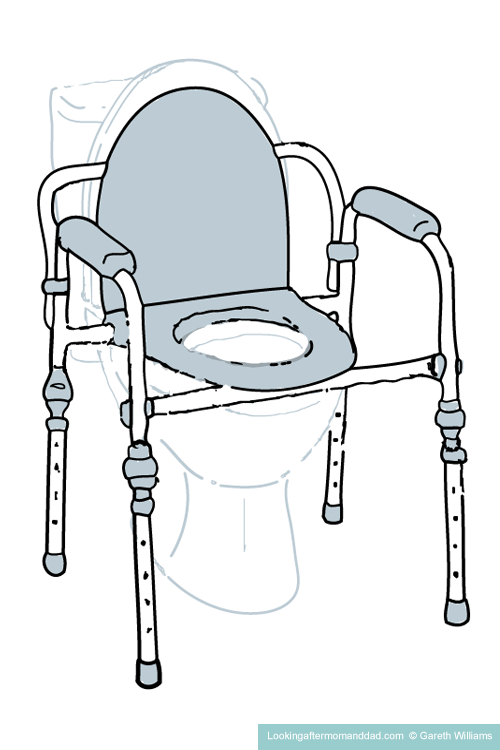
3 in 1 bedside commode installed over a toilet
Bedside commodes are a safe option after hip or knee replacement surgery
- a bedside commode is a great option for a temporary toilet in the bedroom or in another room, as the patient will not be able to move easily at first to get to the toilet, so having one right by them is a big help
- the bedside commode is also far easier than a toilet to sit on after hip surgery, so the risk of injury is far less – due to the way you need to sit down without putting strain on your operated leg, the armrests of a bedside commode are of great assistance both for sitting and standing back up
- after a few days or a week when the surgery has healed a little, and the patient is using the toilet, the bedside commode – if it is a 3-in-1 bedside commode – can be placed over the toilet with the commode seat raised to give the toilet added height, making it much easier for the patient to sit as it is higher
In my article “Best Raised Toilet Seats After A Hip Replacement”, you will find a number of bedside commodes which can be used either over the toilet as a raised toilet seats after a hip or knee replacement, or as a bedside commode anywhere else you care to put them in the home.
Bedside commodes can be quickly placed anywhere needed
- if you are a carer helping a person to use a bedside commode, it is much easier than helping them to use the toilet
- a carer can pick up the commode and quickly put it wherever it is needed if there is an emergency, which obviously is not possible with a ceramic toilet
- once the person is installed, if they do need help with cleaning, you can at least them alone for while they go to the toilet, knowing that they are secure with the armrests and the frame, which you don’t have on the conventional toilet
Bedside commodes can mean more sleep for caregivers
- this is pretty simple, if you don’t have to worry about the person you are caring for calling you or falling on the way to the toilet at night, you will be able to sleep, and to sleep without so much worry
Some bedside commodes come with wheels – rolling commodes
There are two types of bedside commodes on wheels –
- transport bedside commodes
- shower chair transport commodes
Both types have –
- an attendant version
- and a self-propelling version
Use these commodes in multiple situations, and if your loved one has trouble walking, you can use these as a transport chair.
The shower commode is a commode, a shower chair, and a transport chair, making life a lot easier for those who have troubles walking and standing.
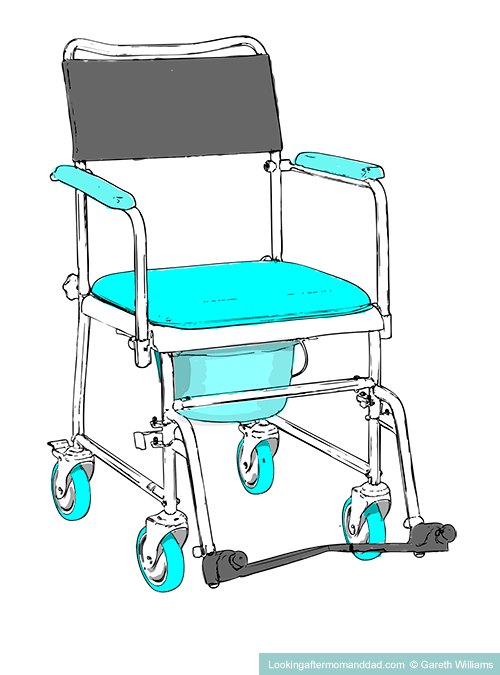
Attendant Transport Commode Chair - with 4 equally sized wheels
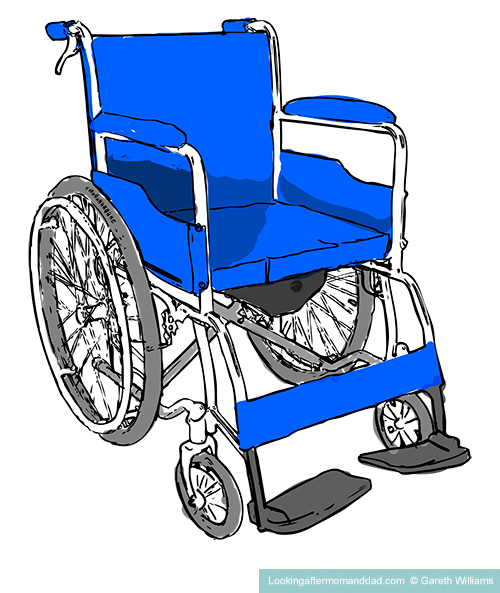
Self-propelled Transport Commode Chair
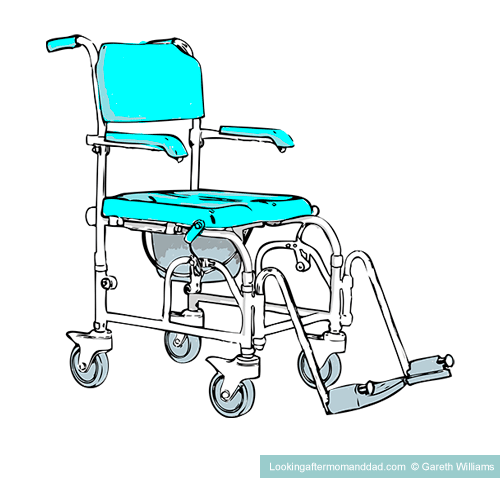
Attendant shower chair transport bedside commodes
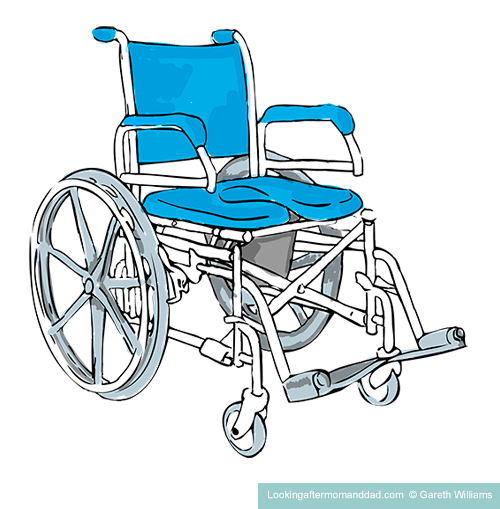
Self-propelled shower chair transport bedside commodes
To learn a lot more about rolling commodes you can read my very in-depth article, complete with lots of examples of the different types of commodes – “What Are The Types Of Commode Chair With Wheels ? How to Make The Right Choice ?”. The article gives the names, types, model numbers and weight capacities of lots of examples, as well as suppliers.
How to use a bedside commode ?
To use a bedside commode, you lift the seat and place the pail in the pail holder.
You have several choices about how you use the commode –
- you can use the bucket, and pour in an inch or two of water before each use
- or you can use disposable commode liners which are bags which you place over and inside the pail before it is used – most come with absorbent pads to absorb liquids
The choice is yours.
If you use liners, you just remove the liner after use, tie it up and place it in the landfill trash.
Without liners, you put about a quart of water in the bottom of the pail, and after use dump it all down the toilet, and clean the bucket.
Bedside commodes are for both peeing and pooping.
You should empty the bedside commode very time it is used, even if it is just urine in there.
I have a guide to using bedside commodes which discusses all aspects of using them, cleaning, setting them up, commode liners, cleaning products, transfers to and from the commode, and you can read that here – “Using A Bedside Commode: An Illustrated Guide”
How to transfer to a bedside commode ?
For fragile individuals, and those with other mobility issues, it is best to use a walker to assist them with the transfer.
To sit down on a bedside commode –
- with the aid of a walker, the user should back up to the bedside commode
- the user should keep holding onto the walker while backing up to keep balance
- back up until the commode frame touches against the back of the user’s legs
- if you are assisting someone on a bedside commode, you may need to help them remove any items of clothing
- as the user sits, they must never tilt the walker towards themselves
- the user should reach back with one hand to take hold of the armrest on that side
- next they should reach for the armrest on the other side
- holding the armrests on either side of the bedside commode, the user can now sit back on the bedside commode seat
- users should try not to sit down too quickly or too violently, as it may cause tipping of the bedside commode
- when seated, the user’s feet should touch the ground
To stand back up from a bedside commode –
- a walker is placed in front of the commode to hold onto when standing
- place both hands on the armrests of the bedside commode, and push up to stand
- the user should then reach forward with one hand taking a hold of the walker with that hand, and then do the same with the other
- once standing, the person who is assisting can help the user to pull up their clothes
While you are looking for bedside commodes, there is lots more that you can do to make your bathroom a safer place for seniors, or anyone else with mobility issues.
To find out all the different things you can do, to have an instant impact on bathroom safety, take a look here, “54 Bathroom Safety Tips For Seniors – A Helpful Guide”.
How to transfer from a bed to a bedside commode ?
A person who cannot stand, and is bedridden, will need to use a transfer commode.
Transfer commodes are extra wide, which allows the user to slide over from the bed onto the commode.
Transfer commodes are also used by wheelchair users, if they do not have enough room around their toilet to transfer safely.
Transferring from a bed to a transfer commode is easiest with a variable height bed –
- the transfer commode is placed up against the side of the bed, with the extra width section being placed up against the bed
- the user moves on to the edge of the bed, so that their legs are parallel with the length of the bed
- the bed is raised so that it is slightly higher than the commode, and then gravity will help the person slide over onto the commode
- the user continues to slide over onto the commode seat
- after the user has finished and is cleaned, the bed needs to be lowered, so it is slightly lower than the transfer commode, gravity will help the person move on to the bed
- the user slides from the seat on to the extension, and back over on to the bed
Installing your bedside commode over a toilet
To install a 3- in-1, or stacking bedside commode over a toilet –
- take the commode bucket out from the bucket platform
- put your toilet seat and lid in the upright position
- adjust the height of the commode legs, so they clear the height of the rim of your toilet bowl from the floor when you place the commode over the toilet
- to get the correct leg height, you depress the spring-loaded button on the leg, and then either pull the leg down to lengthen it, or push it up to shorten it
- the legs must all be the same length for safety reasons
- the spring-loaded buttons must pop out of the holes properly when adjusted to the correct height, they should make a loud clicking sound as they lock into position and stick out
- be careful not to make the bedside commode too high for the user, their feet must not be in the air when seated – it can lead to falls when they try to stand up from the seat
- once you are sure that the legs are set to the correct height, place the bedside commode over the toilet
- if you are creating a space of 3 – 6 inches between the commode frame and the rim of the toilet bowl, you may want to use the splash guard which comes with all commodes which can be used over a toilet
- the splash guard fits into the bucket platform just like the commode bucket
- your commode is now ready for use over the toilet
I’m Gareth, the author and owner of Looking After Mom and Dad.com
I have been a caregiver for over 10 yrs and share all my tips here.

